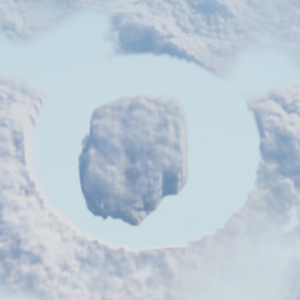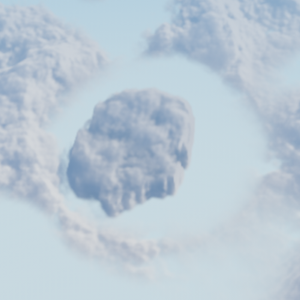Field Weather
A Field Weather is an object that specifies location of local cloud coverage areas within cloud layers. The FieldWeather object allows creating local storms or clouds that have their own coverage texture as well as to control their movement. The number of FieldWeather objects in the scene is not limited as their impact on performance is not significant.
A FieldWeather coverage is visible only when the camera is within the dynamic coverage area, which can be set up via the Settings window.
A FieldWeather object will affect clouds only if the Field mask matches the Field Weather mask of the clouds_base material.

See also#
- The FieldWeather class to manage FieldWeather objects via API
Adding a Field Weather#
To add a FieldWeather object in the world via UnigineEditor, do the following:
- On the Menu bar, choose Create -> Sky -> Field Weather.

- Place the FieldWeather object in the world. It doesn't matter if it intersects a CloudLayer object or not, only X and Y coordinates are used.
- Go to the Node tab of the Parameters window, and set up necessary parameters.
Setting Up Field Weather#
In the Field Weather section (Parameters window -> Node tab), the following parameters of the FieldWeather object can be adjusted:

Setting Bit Masks and Size#
| Field Mask | A field mask. The FieldWeather object is applied to a cloud layer only if they have matching masks. |
|---|---|
| Viewport Mask | A viewport mask. A bit mask for rendering the FieldWeather object into the current viewport. For the FieldWeather object to be rendered into the viewport, its mask should match the camera viewport mask. |
| Size | Size of the FieldWeather object along the axes in units. |
Setting Clouds Parameters#
| Attenuation Type | Type of attenuation shape. This parameters determines the way the local clouds of the FieldWeather object are mixed with the surrounding clouds. Can be one of the following:
|
||||
|---|---|---|---|---|---|
| Attenuation | Attenuation factor indicating how much the coverage texture attenuates starting from the center of the FieldWeather object to its edges.
|
||||
| Power | Determines the contrast of the coverage texture. Makes it possible to gradually increase cloudiness without changing the coverage texture. This parameter is analogous to coverage contrast parameter of the clouds_base material. Notice For this parameter to work properly, the coverage texture must not contain absolutely black pixels. |
||||
| Intensity | Determines the degree of impact of the coverage texture of the FieldWeather object on the clouds. | ||||
| Coverage texture | An RGB8 coverage texture for the FieldWeather object. This texture is similar to the coverage texture of the clouds_base material. | ||||
| Wind Enabled | Indicates whether the local wind inside the FieldWeather object is enabled. | ||||
| Wind | Wind speed in each direction inside the FieldWeather object. The wind along X and Y axes shifts local coverage texture at the specified rates in the corresponding directions. This parameter can be used to animate clouds inside the FieldWeather object. The texture shifting is looped inside the object, as the wind affects only its offset.
Notice
Setting wind speed values to zero does not return the texture to its initial state. In order to return the initial state disable local wind by unchecking the Wind enabled option. |





